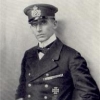The Royal Navy felt that it needed 70 cruisers to provide adequate protection for British trade. They included any cruisers in the Dominion navies in that total as did everyone else. But despite the perceived need and strenuous efforts to achieve that total by the Royal Navy, they never did. I've listed the cruisers they had year by year from 1939 through 1944. I've also divided the cruisers into four categories, Heavy Cruisers (armed w/ 7.5 to 8"), Large Light Cruisers (armed with more than 8x 6"), Small Light Cruisers (armed with 6 or 8 6" or 5.25") and finally Old Light Cruisers (6" cruisers of the E Class or older). The last group includes the various C Class including 4" AA conversions.
So why didn't the navy achieve a total of 70 cruisers? The navy certainly did everything in its power to achieve that total including retaining the older cruisers long after their treaty replacement dates had come and gone. IMHO there were several causes. First and foremost was money or the lack thereof. Admiral of the Fleet, Beatty made a flippant remark to the Chancellor of the Exchequer, Winston Churchill in the middle 20s that haunted the navy from there on. Beatty when asked how many cruisers were needed, replied that the navy needed about 50 cruisers. He failed to explain that it took about 70 cruisers to keep the number at sea at 50. The Government clung to the number 50 as it suited them financially. The second major reason IMHO was the war. The navy got close to obtaining 70 cruisers, but war losses prevented it. As you can see from the list the retention of the older cruisers was vital to getting anywhere near a total of 70. The older cruisers totaled about 25% of the overall cruiser total throughout the war.
I'd just love to hear other opinions on this.
WMC
RN & Dominion Navies Cruisers
1939-64
Heavy Cruisers-17
Kent Class: Berwick, Cornwall, Cumberland, Kent, Suffolk, Australia & Canberra
London Class: Devonshire, Shropshire, Sussex & London
Norfolk Class: Dorsetshire & Norfolk
York Class: York & Exeter
Elizabethan Class: Hawkins & Frobisher
Large Light Cruisers-10
Town Class: Southampton, Newcastle, Birmingham, Glasgow, Sheffield, Gloucester, Liverpool, Manchester, Belfast & Edinburgh
Small Light Cruisers-12
Leander Class: Leander, Achilles, Ajax, Neptune & Orion
Apollo Class: Sydney, Perth & Hobart
Arethusa Class: Arethusa, Aurora, Galatea & Penelope
Old Light Cruisers-25
Elizabethan Class: Effingham
E Class: Emerald & Enterprise
D Class: Danae, Dauntless, Dragon, Delhi, Despatch, Dunedin, Durban & Diomede
C Class: Capetown, Colombo, Calypso, Caledon, Caradoc, Cardiff, Ceres, Calcutta, Carlisle, Cairo, Coventry, Curlew & Curacoa
WWI Town Class: Adelaide
1940-69
Heavy Cruisers-17
Lost: 0
Large Light Cruisers-13
Lost: 0
Colony Class: Fiji, Kenya & Nigeria
Small Light Cruisers-16
Lost: 0
Dido Class: Dido, Bonaventure, Naiad & Phobe
Old Cruisers-23
Lost-2
1941-69
Heavy Cruisers-16
Lost: 1
Large Light Cruisers-15
Lost: 3
Colony Class: Mauritius
Small Light Cruisers-17
Lost: 3
Dido Class: Euryalus, Hermione, Cleopatra & Charybdis
Old Light Cruisers-21
Lost: 2
1942-61
Heavy Cruisers-13
Lost: 3
Large Light Cruisers-15
Lost: 3
Colony Class: Gambia, Jamaica & Bermuda
Small Light Cruisers-15
Lost: 3
Dido Class: Scylla & Argonaut
Old Light Cruisers-18
Lost: 3
1943-67
Heavy Cruisers-13
Lost: 0
Large Light Cruisers-18
Lost: 0
Colony Class: Uganda, Newfoundland & Ceylon
Small Light Cruisers-18
Lost: 1
Dido Class: Spartan, Bellona, Black Prince & Royalist
Old Light Cruisers-18
Lost: 0
1944-65
Heavy Cruisers-13
Lost: 0
Large Light Cruisers-18
Lost: 0
Small Light Cruisers-18
Lost: 1
Dido Class: Diadem
Old Light Cruisers-16
Lost: 2








